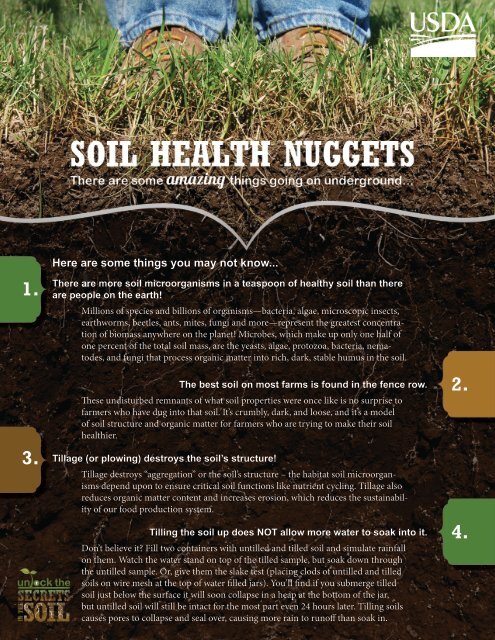Read More - Natural Resources Conservation Service
Read More - Natural Resources Conservation Service
Read More - Natural Resources Conservation Service
Create successful ePaper yourself
Turn your PDF publications into a flip-book with our unique Google optimized e-Paper software.
1.<br />
3.<br />
Here are some things you may not know...<br />
There 1are more soil microorganisms in a teaspoon of healthy soil than there<br />
are people on the earth!<br />
Millions of species and billions of organisms—bacteria, algae, microscopic insects,<br />
earthworms, beetles, ants, mites, fungi and more—represent the greatest concentration<br />
of biomass anywhere on the planet! Microbes, which make up only one half of<br />
one percent of the total soil mass, are the yeasts, algae, protozoa, bacteria, nematodes,<br />
and fungi that process organic matter into rich, dark, stable humus in the soil.<br />
The best soil on most farms is found in the fence row.<br />
These undisturbed remnants of what soil properties were once like is no surprise to<br />
farmers who have dug into that soil. It’s crumbly, dark, and loose, and it’s a model<br />
of soil structure and organic matter for farmers who are trying to make their soil<br />
healthier.<br />
Tillage (or plowing) destroys the soil’s structure!<br />
Tillage destroys “aggregation” or the soil’s structure – the habitat soil microorganisms<br />
depend upon to ensure critical soil functions like nutrient cycling. Tillage also<br />
reduces organic matter content and increases erosion, which reduces the sustainability<br />
of our food production system.<br />
Tilling the soil up does NOT allow more water to soak into it.<br />
Don’t believe it? Fill two containers with untilled and tilled soil and simulate rainfall<br />
on them. Watch the water stand on top of the tilled sample, but soak down through<br />
the untilled sample. Or, give them the slake test (placing clods of untilled and tilled<br />
soils on wire mesh at the top of water filled jars). You’ll find if you submerge tilled<br />
soil just below the surface it will soon collapse in a heap at the bottom of the jar,<br />
but untilled soil will still be intact for the most part even 24 hours later. Tilling soils<br />
causes pores to collapse and seal over, causing more rain to runoff than soak in.<br />
2.<br />
4.
5.<br />
7.<br />
9.<br />
OMG! Organic Matter (half) Gone!<br />
The Morrow Plots on the campus of the University of Illinois indicate soil organic<br />
matter content in prairie grass borders was 5.5 to 6.5 percent in 1876. Less than half<br />
of that is left. That’s the case with most prairie soils—oxidation of organic matter<br />
from tillage for row crops has reduced organic matter levels to between 2 - 3 percent<br />
today.<br />
A farmer’s favorite cocktail mix might not be what you think.<br />
Innovative farmers are breathing new life into their soil by seeding a “cocktail mix”<br />
of 6-12 plants to get diversity above-ground, which creates much-needed diversity<br />
below the ground. Through that diversity, farmers are mimicking the soil-building<br />
and microbial-friendly conditions of the diverse native prairies.<br />
If you want your soil to be healthy, you shouldn’t see it very often.<br />
That’s because you want that soil to be covered all the time, preferably with living<br />
plants. Keeping the soil covered all the time makes perfect sense when you realize<br />
that healthy soils are full of life. The microorganisms living in the soil need food and<br />
cover to survive – just like other living creatures.<br />
Roots of some plants can grow 3-feet deep in 60 days!<br />
That’s right, roots of daikon type radishes are a biological alternative to deep ripping<br />
to alleviate soil compaction. After radishes winter kill the channels created by the<br />
roots tend to remain open at the surface, improving infiltration, surface drainage<br />
and soil warming. The popular cover crop also is an excellent nitrogen scavenger.<br />
What did President Thomas Jefferson know that we don’t?<br />
<strong>More</strong> than 200 years ago, Thomas Jefferson, a farmer and conservationist, used<br />
vetch, turnips, peas, and clover as cover crops and in rotation. He used these crops<br />
on his Virginia plantation to build soil that he knew was being depleted with his<br />
tobacco cash crop.<br />
Multiple “bennies” through multiple species.<br />
The below-ground synergy created by crop rotations and multi-species cover crops<br />
can actually accelerate biological time by increasing organic matter, allowing crops<br />
to flourish in dry times while monocultures struggle. And as an added bonus,<br />
diverse cover crop mixtures work together to crowd out weeds, improve nutrient<br />
cycling and reduce plant diseases.<br />
6.<br />
8.<br />
10.<br />
United States Department of Agriculture<br />
<strong>Natural</strong> <strong>Resources</strong> <strong>Conservation</strong> <strong>Service</strong><br />
www.nrcs.usda.gov<br />
USDA is an equal opportunity provider and employer.
















